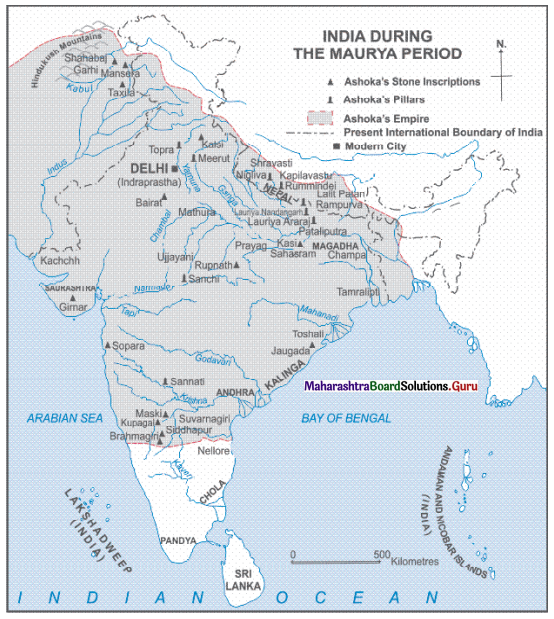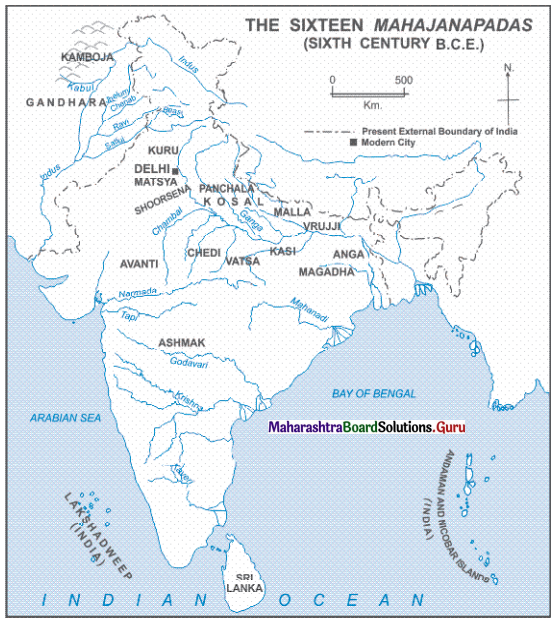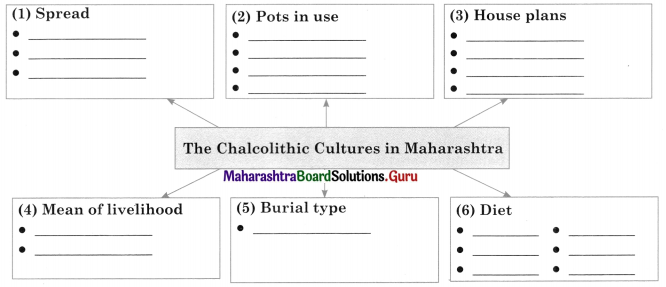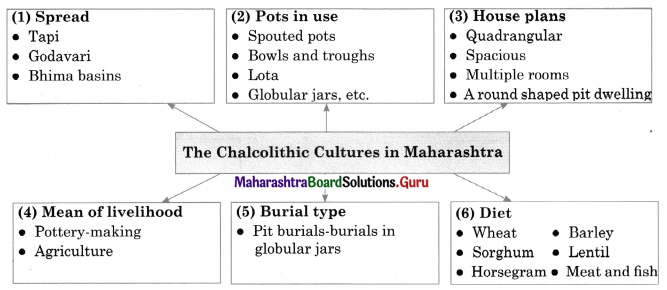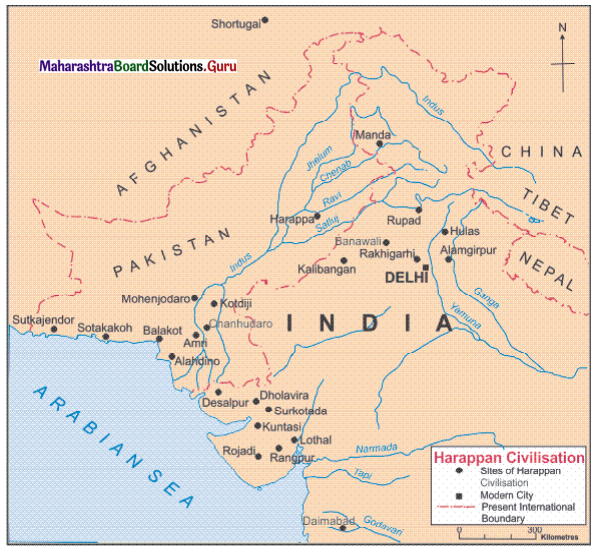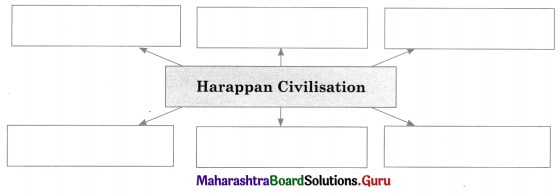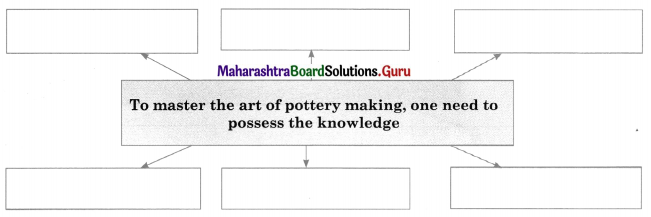Balbharti Maharashtra State Board Class 11 History Important Questions Chapter 9 Post Mauryan India Important Questions and Answers.
Maharashtra State Board 11th History Important Questions Chapter 9 Post Mauryan India
1A. Choose the correct alternative and write complete sentences.
Question 1.
___________ established a second capital at Vidisha.
(a) Chandragupta Maurya
(b) Bimbisara
(c) Pushyamitra Shunga
(d) Hala
Answer:
(c) Pushyamitra Sunga
Question 2.
The ___________ mention the ‘Andhras’ or ‘Andhrabhrutyas’.
(a) Puranas
(b) Upanishadas
(c) Vedas
(d) Jain Tools
Answer:
(a) Puranas
![]()
Question 3.
___________ was the smallest unit of administration.
(a) Kingdom
(b) State
(c) Grama(village)
(d) District
Answer:
(c) Grama
Question 4.
___________ wrote Brihatkatha.
(a) Hala
(b) Gunadhya
(c) Patanjali
(d) Panini
Answer:
(b) Gunadhya
Question 5.
Gatha Saptashati reflects the social life in ___________ of the Satavahana period.
(a) Maharashtra
(b) Tamilnadu
(c) Uttar Pradesh
(d) Bihar
Answer:
(a) Maharashtra
Question 6.
___________ wrote the ‘Mahabhashya’ based on Panini’s Ashtadhyayi’
(a) Gunadhya
(b) Patanjali
(c) Banabhatta
(d) Kalidasa
Answer:
(b) Patanjali
Question 7.
___________ was the head of trade guilds.
(a) Shreshthi
(b) Sarthavaha
(c) Malakara
(d) Dasaka
Answer:
(a) Shreshthi
![]()
1B. Find the incorrect pair from set B and write the correct ones.
Question 1.
| Set ‘A’ | Set ‘B’ |
| (a) Pushymitra shunga | Shisunaga dynasty |
| (b) Chandragupta Mauryan | Mauryan dynasty |
| (c) Gautamiputra Satakarni | Satavahana dynasty |
| (d) Mahapadma Nanda | Nanda dynasty |
Answer:
(a) Pushyamitra Shunga – Shunga dynasty
Question 2.
| Set ‘A’ | Set ‘B’ |
| (a) Pratishthan | Paithan |
| (b) Tagar | Ter |
| (c) Nasik | Nashik |
| (d) Karhatak | Viharas |
Answer:
(d) Karhatak – Karhad
Question 3.
| Set ‘A’ | Set ‘B’ |
| (a) Lekhanika | Scribes |
| (b) Vaidya | Traders of perfumes |
| (c) Halakiya | Cultivators |
| (d) Suvarnakar | Goldsmith |
Answer:
(b) Vaidya – Physicians
1C. Find the odd one out.
Question 1.
Shri Satakarni Yajna Satakarni, Hala, Pushyamitra Shunga
Answer:
Pushyamitra Shunga
Question 2.
Vardhaki, Halakiya, Malakara, Lohavanija
Answer:
Halakiya
Question 3.
Amatya, Naigam, Dasaka, Sarthavaha
Answer:
Dasaka
Question 4.
Malakara, Lekhanika, Vaidya, Halakiya
Answer:
Malakara
![]()
Question 5.
Pratishthan, Tagar, Nasik, Sarthavaha
Answer:
Sarthavaha
2A. Write the names of historical places, persons, and events.
Question 1.
Greek king defeated by Pushyamitra Shunga
Answer:
King Demetrius
Question 2.
Ashtadhyayi
Answer:
Panini
Question 3.
Last king of the Shunga dynasty
Answer:
Devbhuti
Question 4.
Mountain pass on the ancient trade route in Maharashtra
Answer:
Naneghat
Question 5.
Head of trade guilds
Answer:
Shreshthi
Question 6.
Blacksmith
Answer:
Lohavanija
![]()
Question 7.
Chief of caravan merchant
Answer:
Sarthavaha
Question 8.
Traders of perfumes
Answer:
Gandhika
Question 9.
Goldsmith
Answer:
Suvarnakar
Question 10.
Physicians
Answer:
Vaidya
2B. Choose the correct reason and complete the sentence.
Question 1.
The Satavahana rule declined due to ___________
(a) weak rulers
(b) the constant struggle between Sakas and Satavahanas
(c) economic decline
(d) social decline
Answer:
(b) the constant struggle between Sakas and Satavahanas
Question 2.
Grama was an integral part of the ___________
(a) central machinery
(b) middle machinery
(c) outdoor machinery
(d) absolute machinery
Answer:
(a) central machinery
![]()
Question 3.
Many Satavahana inscriptions are found in ___________
(a) South Maharashtra
(b) Northwest Maharashtra
(c) North Maharashtra
(d) Central Maharashtra
Answer:
(c) North Maharashtra
Question 4.
___________ reflects the social life in Maharashtra of Satavahana period.
(a) Lohavanija
(b) Dasaka
(c) Halakiya
(d) Gatha Saptashati
Answer:
(d) Gatha Saptashati
3. Complete the concept maps.
Question 1.

Answer:

Question 2.

Answer:

![]()
Question 3.

Answer:

Question 4.

Answer:

4. Write short notes.
Question 1.
Guilds or Shrenis
Answer:
- Many industries and trade flourished under the Satavahas.
- Various shrenis (Guilds) emerged during this period.
- The trade and industries were controlled with the help of these shrenis.
- The shrenis also provided loans.
5. Explain the following statements with reasons.
Question 1.
Foreigners like Greek, Pallavas, and Kushanas were absorbed in the social structure.
Answer:
- The invasion of foreigners like Greek, Pallavas, Shakas, and Kushanas took place during the Satavahana period.
- But these foreigners were soon absorbed in the social structure.
- This means that contemporary society was flexible enough to accommodate foreigners.
- The political invasions brought about social, economic, and cultural changes.
Question 2.
The influence of Persian and Greek sculptural styles of the Mauryan period decreased during the Shunga and Satavahana period.
Answer:
- A new native Indian style of architecture developed or emerged in this period.
- For e.g., the four gateways (Toranas) of the Sanchi Stupa No. 1 built during this period are excellent examples of this style.
- Many incidents from the life of Gautama Buddha are carved on these gateways.
- A number of rock-cut caves (Viharas and Chaityas) at Bhaje, Nashik, Karle, etc. belong to the Satavahana period.
- Especially the Chaitya at Karle, its magnificent facade entrance and sculptures are the finest examples of the sculptural art of this period.
![]()
6. State your opinion.
Question 1.
Before Gautamiputra Satakarni some of the Satavahana kings were not capable.
Answer:
- Taking advantage of the situation, the Shaka Satrapas established their rule in the western regions of India.
- Gautamiputra Satakarni, the Satavahana king conquered the Shakas.
- The Satavahana dynasty regained its strength with this victory.
- Thus, before Gautamiputra Satakarni some of the Satavahana kings were not capable.
Question 2.
The Shungas contribution to the field of art is important.
Answer:
- The Shunga’s contributed to art in a big way.
- The stupas at Sanchi and Bharhut, Garuda pillar at Besnagar are excellent examples of art during this period.
- The sculptural art in the Shunga period widened its horizons and depicted the life of common people on a large scale.
- Thus, the Shungas’ contribution to the field of art is important.
7. Answers the questions in detail.
Question 1.
Write a detailed note on the Shunga Empire.
Answer:
- The Shunga Empire was founded by Pushyamitra Shunga.
- The Shunga Empire extended from Magadha in the east to Sialkot (Punjab) in the west as well as the Himalayas in the North to Vidarbha in the south.
- Pushyamitra established a second capital at Vidisha although Pataliputra was the main capital. Pushyamitra was valiant and ambitious.
- He strengthened his rule in the provinces of Kosala, Vatsa, Avanti, etc.
- Later he conquered the lost provinces of the Magadha empire up to Sialkot.
- The Greek king Demetrius was repelled by Pushyamitra.
- After establishing his rule over North India and some parts of South India he performed the Ashwamedha sacrifice twice.
- Sanskrit was encouraged. Many texts were reviewed. The Manusmriti was composed during this period.
- Along with literature, art was encouraged for e.g., the Sanchi and Bharhut stupas and the Garuda pillar at Besnagar are excellent examples of art during this period.
- Sculptural art widened its horizons and districted the life of common people on a large scale.
![]()
Question 2.
Give an account of the rise of the Satavahana Empire.
Answer:
- After the disintegration of the Mauryan Empire, many new powers arose. Among them, the Satavahanas are mentioned as the earliest ruling dynasty in Maharashtra.
- The Satavahanas ruled over a vast region of Maharashtra, Andhra, and Karnataka.
- Paithan in Maharashtra was the capital of the Satavahanas. The mention of Puranas the Andhras or ‘Andhrabhrutyas’ Probably these terms refer to the Satavahanas.
- Simuka was the first Satavahana king to be mentioned in the Naneghat inscription.
- The most important king of this dynasty was Shri Satakarni, Hala, Gautamiputra Satakarni and Yajna Satakarni.
- Gautamiputra Satakarni conquered the Shakas and also Central India and the entire regions of Dakshinapatha.
- He also established his dominance over the Republic states in Central India and Rajasthan.
- Gautamiputra proved his strength by gaining victory over Nahapana.
- The Satavahana rule became weak due to the constant struggle between Shakas and Satavahanas.
8. Explain the concept with examples.
Question 1.
Metronomic
Answer:
The Satavahana kings used Metronomics i.e., using the names of their mothers as prefixes for e.g., Gautamiputra Satakarni. Vasishthiputra Pulumavi etc.
Question 2.
Shakapahlavyavannisudan
Answer:
Gautamiputra Satakarni is mentioned as ‘Shakapahlavyavarnnisudan’ i.e. the destroyer of Shakas, Pallavas, and Greeks in the Nashik inscription of his mother Gautami Balashri.
Question 3.
Satavahanakulayashahpratishthapankar
Answer:
Gauthamiputra Satakarni has been referred to as ‘Satavahanakulayashahpratishapankar’ in the Nashik inscription of his mother Gauthami Balashri.
![]()
Question 4.
Trisamudratoyapitavahana
Answer:
Gautamiputra Satakarni has been mentioned as ‘Trisamudratoyapitavahana’ i.e., One whose horses drank the water of the three seas. Such a type of mentioning indicates that many kings in the southern region must have accepted feudatory status and ruled under the suzerainty of Gautamiputra Satakarni.
